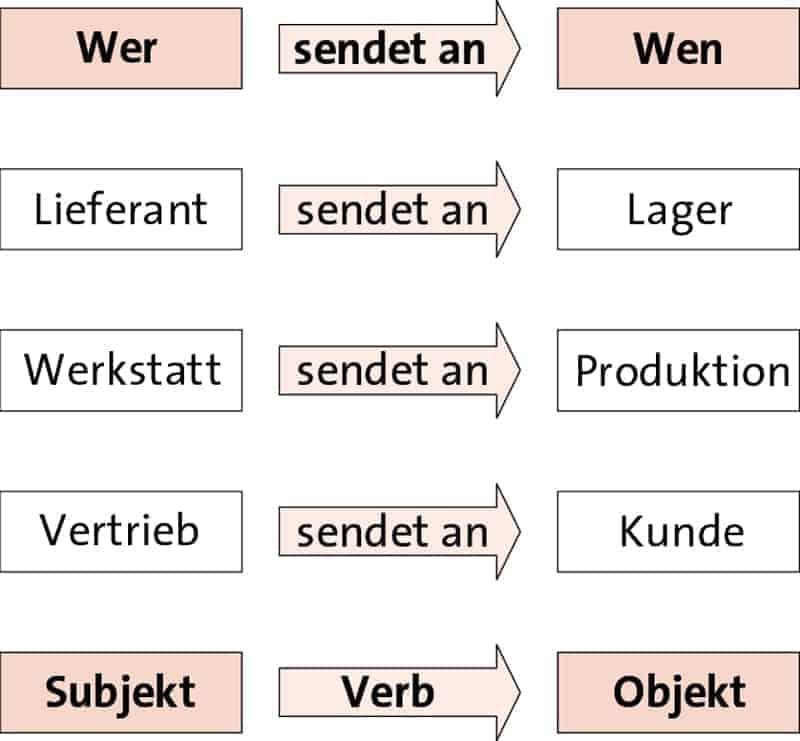How I learned to speak
![[shutterstock: 1241250979, Maksim Kabakou]](https://e3mag.com/wp-content/uploads/2021/03/Digital-Transformation.jpg)

SAP follows the "old-new" motto of offering a solution for integrated business processes. Of course, not even Mr. Färbinger wants to conjure up the primeval times of R/1, R/2 or R/3, but there is a lot of truth in what he is hymnally singing about: Technology has leapt far; performance is breathtaking; user front-ends open up design opportunities for efficient and inviting usability; something is coming "on top" at all corners. But at its core, the issue remains the same: How do we interact with each other? How do we talk to each other?
For this interaction project, the famously gray-haired, sleeve-sleeve-wearing cost accountants used a model that sends a shiver down your spine just by its name - Betriebsabrechnungsbogen - dust flakes swirling.
Stop, stop, stop, esteemed materials managers, logisticians, maintenance people, HR managers, sales people, finance people and process experts of all other provenances: Please stay in the article for a moment, because in the very next image your area of expertise comes into play.
(1) Employees contribute their labor. (2) Suppliers provide goods and services. (3) The workshop sends repair services. (4) Raw materials go from the warehouse to the production order. (5) The production cost center allocates machine services. (6) The production order is delivered. (7) Finished goods are picked from the warehouse and (8) shipped to the customer. This goods issue is followed by (9) the outgoing invoice and finally (10) the incoming payment.
The whole picture is ordered according to the pattern subject, predicate, object. Each activity (= predicate or verb) between subject (= sender) and object (= receiver) can be refined. The "drilldown" visualizes the quantity flow, which is followed by the value flow via G/L accounts.

The SAP Depths
I confess that, like Ulysses, I have to tie myself to the mast in order not to let the model drag me into the (in)depths of moving average and standard prices, price differences, distribution, apportionment, billing, tariff determination, service charging, invoicing, etc. I am tempted to speak of the outlined core method as the song of the sirens, who, as is well known, charmed not only with their beautiful voice (should mean here: with the simplicity and clarity of the presentation).
Above all, they beguiled with their ability to "know and reveal everything that happens on earth" - which here means that this model goes to the SAP depths of posting and offsetting entries, MM account determination and transaction types, business processes and transactions, customizing, tables and programs.

Complexity vs. reduction
Too simple? Cold coffee? Old wood? But that's exactly the point: the technology has become very powerful. The amount of players involved has grown insanely and their specialized skills take a layman's breath away. The organizational, accounting, cost accounting, logistical, management challenges are spectacular. The process and value chain is fascinating in detail and span. This is precisely why it is a matter of replicating the complex events in a reduced form at each stage in order to get to the core.
With this guiding principle, I propose to consistently use the sentence building blocks of our word language - subject, predicate and object - as the syntax of a visual language for business and booking processes. With this pattern of words and images, we can speak simply and clearly, consistently and consistently, visualize, model who does what and (then) interact with whom: Which people, instances, account objects, technical systems are involved in the process and in which role?
What activities and business processes do they perform? What effects are created for prices, quantities, values, messages? With which transactions are the activities executed? In which tables is the master data stored? In which tables are the transaction data (prices, quantities, values) posted?
The sketched image focuses on the flow of information between the participants triggered by activities. This process dimension visualizes the interaction between subject and object, system and program. The second important dimension, namely the step sequence of the activities, i.e. the process flow, can also be visualized in the same model.

Accordingly, the core method organizes the events into two flow variables: First, information flow with the information types price, quantity, value, messages (for example, texts); and second, process flow as a step sequence of activities with decisions (AND, OR, XOR) to perform the activities.
R/3 and S/4 world
Operational practice can benefit greatly from this change of perspective. The wave of migrations from the R/3 to the S/4 world, which is growing over time, opens up the same opportunity for this generation as was given to the "children" of the R/3 wave in the 1990s: the opportunity to critically question business processes, to understand them correctly, and to redesign them.
We should make this crucial resource for productivity gains - know, order, understand, apply - accessible to the "people of the new SAP generation". The change from R/3 to S/4 is about more than migration technology: it's about technology, namely understanding what you do better in the future than you do today. With a little distance and then viewed as a whole, the model is old news - after all, we've always thought and talked this way. But as I said at the beginning: Old wood also burns - and usually even particularly well.





